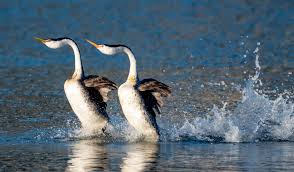These used to feel like different worlds.
There were humans, with their cities and streets and such. And somewhere beyond, there was nature.
“Nature was ‘other,’” filmmaker Nate Dappen said. “It was something that you went to find and it wasn’t happening here.”
Until we found it everywhere. An example is “San Diego: America’s Wildest City” (shown here) at 8 p.m. Wednesday (Nov. 6) on PBS, under the “Nature” banner.
Yes, San Diego is thoroughly civilized – 1.3 million people in the city, two million more in the county. It’s known for opera, theater and major-league baseball and soccer. Despite – or partly because of – all those people, it’s also considered the most bio-diverse city in the continental U.S.
That’s due to its geography, Fred Kaufman, the “Nature” producer, told the Television Critics Association. San Diego is “settled between the Mojave Desert, the Pacific Ocean (and) the Sierra Mountains.” Its wildlife ranges from hummingbirds to whales, plus coyotes, bobcats and rattlesnakes.
And it’s partly due to the human impact.
“Urbanization is happening all over the world, very rapidly,” Dappen told the TCA. “And a lot of species are not rising to the challenge.”
But the ones that do are thriving. That includes:
— Crows. “Crows weren’t even in San Diego until the ‘70s, ‘80s, and now they’ve exploded,” he said. “They can use all of our resources.”
— Coyotes. “We are inviting them into our neighborhoods with open arms and not realizing … that’s not normal behavior,” said Benay Karp, an expert on the species. She prefers to yell at them, so they don’t get habituated.
— Hummingbirds. “There’s way more flowers in the urban environment, because of the water we pump into the city,” Dappen said. That lures birds – and others. “When you get the density of hummingbirds, all of a sudden, species that don’t eat them normally start spending a lot more time looking for them. He even got rare footage of a roadrunner – yes, like in the cartoons – successfully stalking at a hummingbird feeder.
— And grebes (shown here), which are clearly the stars of the film.
“There were almost no grebes in San Diego,” Dappen said, “until we built these reservoirs, until we dammed all the rivers …. Now they’re the most abundant bird species on the lake.”
And the most telegenic. As they skim along the surface, they appear to be walking on water – maybe dancing on it. They provide a memorable start and finish to a film about wild San Diego.

It’s a wild world — even in our cities
These used to feel like different worlds.
There were humans, with their cities and streets and such. And somewhere beyond, there was nature.
“Nature was ‘other,’” filmmaker Nate Dappen said. “It was something that you went to find and it wasn’t happening here.”
Until we found it everywhere. An example is “San Diego: America’s Wildest City” (shown here) at 8 p.m. Wednesday (Nov. 6) on PBS, under the “Nature” banner Read more…